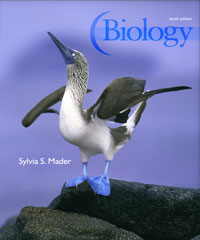Biology (Mader), 10th EditionChapter 39:
Locomotion and Support SystemsLearning OutcomesAfter studying this chapter, you should be able to accomplish the following outcomes.
Diversity of Skeletons - Distinguish between endoskeletons and exoskeletons, and provide examples of each.
- Define hydrostatic skeleton and explain how it provides support and enables movement.
The Human Skeletal System- List the five main functions of the human skeleton.
- Describe bone development, including the roles of osteoblasts, osteoclasts, and osteocytes.
- Describe the structure of a long bone; differentiate between spongy and compact bone.
- List the parts of the osteon.
- List the components of the human axial skeleton and appendicular skeleton.
The Human Muscular System- List the three types of muscle tissue found in humans.
- Describe how skeletal muscles act antagonistically.
- Distinguish between tetanus and tone.
- Summarize the microscopic structure of skeletal muscle tissue and the sliding filament model of muscle contraction.
- Describe the structure and function of the neuromuscular junction.
- Describe the roles of calcium (Ca2+) and ATP in muscle contraction.
Health Focus: You Can Avoid Osteoporosis- Explain what osteoporosis is.
- List the major risk factors for osteoporosis.
- Describe how osteoporosis may be prevented.
 | 




